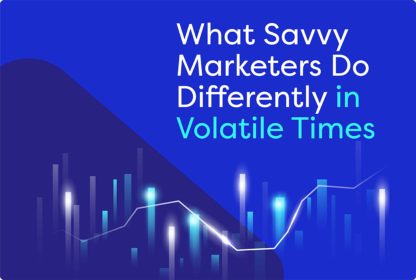It’s Spooky Season, a time for tricks and treats. It also signals just two more months left of 2023, which has us all thinking about the good and bad in store for 2024. All signs point to a dynamic year ahead, from Google finally phasing out third-party cookies and multiple states enacting privacy laws to a presidential election-all while the economy continues to steer towards a (hopefully) soft landing.
We decided to survey a few marketers about what’s giving them the creepie-crawlies when looking ahead to 2024. Here are the major themes they shared—and how they can shed their scaries as they plan for next year.
“The performance I’m not measuring”
A big thing on marketers’ minds is what to measure and how to measure it. Brands can now use various channels to reach their audiences, from newer ones like TikTok and retail media to older ones like direct mail and email. At the same time, the legacy ways of measuring marketing performance are falling by the wayside thanks to privacy legislation and browser identifier changes.
“Marketing is always evolving as people’s preferences change, and with AI and other new ideas, programs, and products, what should I be tracking to stay ahead of change versus just reacting to it?” asked one of our survey respondents, Melsha Key, senior marketing manager, acquisition and retention loyalty, at Gap Inc. Another respondent noted that “measurement on upper-funnel awareness advertising” was challenging.
As we’ve discussed before, marketers must master coordinating online and offline tactics via hybrid channels, such as Programmatic Direct Mail, to get a more holistic picture of their customers and close the loop on performance. PebblePost’s PDM audiences are built around household postal addresses, which means we can match transactions from any point of sale back to the people that received the message on a 1:1 basis. This essentially fills in the offline performance gaps invisible to most digital-only channels.
“Uncertain economic forecast”/“Unrealistic targets paired with shrinking budgets”
Everyone has been waiting for the next recession to hit. The fact that it still hasn’t does not seem to provide even temporary relief for brands. Of those we surveyed, one brand said it’s been harder to forecast trends, which have already been fluctuating since 2020. A second brand said demand is low in retail right now, while another said the industry is in a delicate place.
“We’ve been talking about the incoming recession all year—how will this negatively impact my business?” asked survey respondent Kaitlyn Delia of Boll and Branch. “How can I navigate this challenging climate?”
Despite continued inflation and high interest rates, the U.S. Bank reports that the economy has grown steadily this year. This is largely thanks to continued consumer spending, which will likely keep a recession at bay in 2023. Keeping this spend going is why brands must continue investing in advertising to reach consumers.
The key is to identify those shoppers with the greatest intent to buy so that marketers don’t waste their precious and, in many cases, slashed budgets. PDM is the precision tool for the job. It uses household-based targeting, accurately suppresses existing customers, and applies billions of online intent signals refreshed daily so brands only target the customers most likely to purchase from them.
“Third-party cookie deprecation”/“Rapidly changing privacy regulations”
The continued evolution of the privacy landscape is also keeping marketers up at night. And it makes sense since 2024 looks to be the year that third-party cookies finally go away for good. In addition, a number of states plan to put their own privacy laws into effect. Even with years to prepare for this moment, it’s understandable that many brands are still at a loss for how they can target consumers without legacy identifiers.
Household postal addresses present a powerful option for replacing third-party cookies for several reasons.
- First, they have staying power—they can’t be erased by a browser’s cache or a browser switch—and are a more reliable identifier because they only require an up-to-date address.
- Second, marketers have used addresses in direct mail campaigns for decades, meaning they have a robust CRM filled with customers’ home addresses.
- Third, household postal addresses link consumers across the entire digital and physical worlds and the purchase funnel, from registration through to purchase.
- And fourth, on that note, a valid postal address lets marketers match online activities with offline purchases with near-deterministic certainty, enabling a holistic view of customer behavior.
At PebblePost, our solutions are built around households, providing the brands we work with a reliable, scalable way to discover, engage, and retain customers and fuel sustainable growth no matter what might come.
There’s certainly a lot for marketers to think about heading into 2024. But by prioritizing the right hybrid channels that allow for a complete view of customer behavior, closed-loop measurement, and a future-proofed way to identify consumers online and offline, brands can get ahead before they can say “Boo.”



